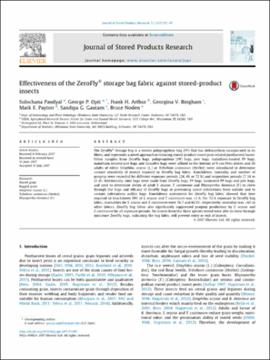| dc.contributor.author | Paudyal, Sulochana | |
| dc.contributor.author | Opit, George P. | |
| dc.contributor.author | Arthur, Frank H. | |
| dc.contributor.author | Bingham, Georgina V. | |
| dc.contributor.author | Payton, Mark E. | |
| dc.contributor.author | Gautam, Sandipa G. | |
| dc.contributor.author | Noden, Bruce | |
| dc.date.accessioned | 2022-04-12T13:55:03Z | |
| dc.date.available | 2022-04-12T13:55:03Z | |
| dc.date.issued | 2017 | |
| dc.identifier | oksd_noden_effectivenessofthezerofly_2017 | |
| dc.identifier.citation | Paudyal, S., Opit, G. P., Arthur, F. H., Bingham, G. V., Payton, M. E., Gautam, S. G., & Noden, B. (2017). Effectiveness of the ZeroFly storage bag fabric against stored-product insects. Journal of Stored Products Research, 73, pp. 87-97. https://doi.org/10.1016/j.jspr.2017.07.001 | |
| dc.identifier.uri | https://hdl.handle.net/11244/335199 | |
| dc.description.abstract | The ZeroFly Storage Bag is a woven polypropylene bag (PP) that has deltamethrin incorporated in its fibers, and represents a novel approach to reducing stored-product insect pest-related postharvest losses. Fabric samples from ZeroFly bags, polypropylene (PP) bags, jute bags, malathion-treated PP bags, malathion-treated jute bags and GrainPro bags were affixed to the bottom of 9-cm Petri dishes and 20 adults of either Sitophilus oryzae (L.) or Tribolium castaneum (Herbst) were introduced to determine contact sensitivity of insects exposed to ZeroFly bag fabric. Knockdown, mortality and number of progeny were recorded for different exposure periods (24, 48 or 72 h) and oviposition periods (7, 14 or 21 d). Additionally, mini bags were made from ZeroFly bags, PP bags, laminated PP bags and jute bags, and used to determine ability of adult S. oryzae, T. castaneum and Rhyzopertha dominica (F.) to chew through the bags and efficacy of ZeroFly bags at preventing insect infestations from outside and to contain infestations within bags. Knockdown assessment for ZeroFly bag fabric showed that time required to knockdown 99% of S. oryzae and T. castaneum was <3 h. For 72-h exposure to ZeroFly bag fabric, mortalities for S. oryzae and T. castaneum were 76.7 and 62.2%, respectively; mortality was </=6% in other fabrics. ZeroFly bag fabric also significantly suppressed progeny production by S. oryzae and T. castaneum for all exposure periods. No insects from the three species tested were able to chew through miniature ZeroFly bags, indicating the bag fabric will prevent entry or exit of insects. | |
| dc.format | application/pdf | |
| dc.language | en_US | |
| dc.publisher | Elsevier BV | |
| dc.relation.ispartof | Journal of Stored Products Research, 73 | |
| dc.rights | This material has been previously published. In the Oklahoma State University Library's institutional repository this version is made available through the open access principles and the terms of agreement/consent between the author(s) and the publisher. The permission policy on the use, reproduction or distribution of the material falls under fair use for educational, scholarship, and research purposes. Contact Digital Resources and Discovery Services at lib-dls@okstate.edu or 405-744-9161 for further information. | |
| dc.title | Effectiveness of the Zerofly storage bag fabric against stored-product insects | |
| dc.date.updated | 2022-04-07T14:43:40Z | |
| osu.filename | oksd_noden_effectivenessofthezerofly_2017.pdf | |
| dc.description.peerreview | Peer reviewed | |
| dc.identifier.doi | 10.1016/j.jspr.2017.07.001 | |
| dc.description.department | Entomology and Plant Pathology | |
| dc.type.genre | Article | |
| dc.type.material | Text | |
| dc.subject.keywords | 0608 Zoology | |
| dc.subject.keywords | Entomology | |
| dc.identifier.author | ScopusID: 57190883255 (Paudyal, S) | |
| dc.identifier.author | ScopusID: 6603435544 (Opit, GP) | |
| dc.identifier.author | ScopusID: 7003850264 (Arthur, FH) | |
| dc.identifier.author | ScopusID: 8237833100 (Bingham, GV) | |
| dc.identifier.author | ScopusID: 35592260000 (Payton, ME) | |
| dc.identifier.author | ScopusID: 36544934600 (Gautam, SG) | |
| dc.identifier.author | ORCID: 0000-0002-0096-370X (Noden, B) | |
| dc.identifier.author | ScopusID: 6601968347 (Noden, B) | |
